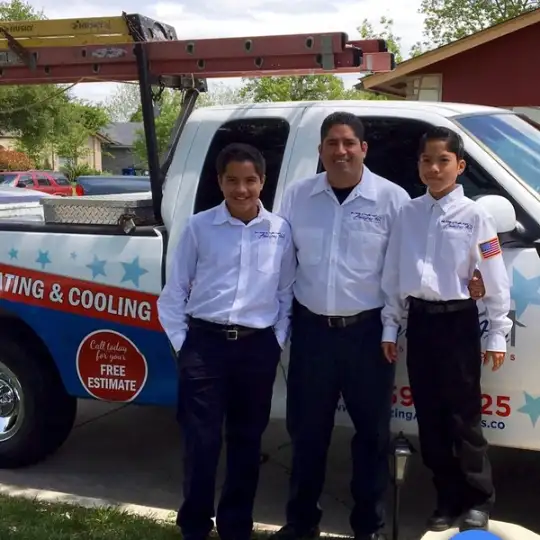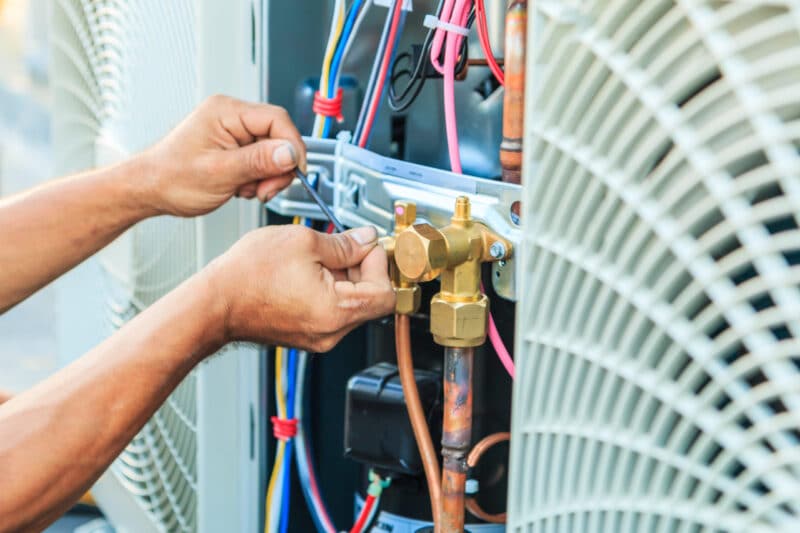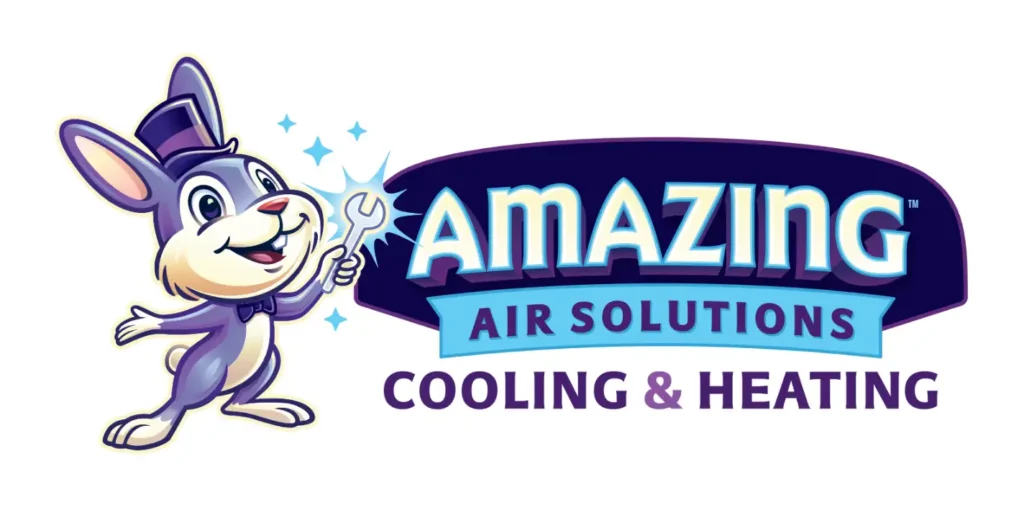
Need a reliable San Antonio AC and heating company to handle your cooling and heating needs? Reach out Amazing Air Solutions’s skilled team today and see why we’re one of the most trusted names in the area for exceptional service!
What you get from Amazing Air Solutions:
Don't wait until your A/C goes out on a hot summer day! Call us today to schedule your maintenance appointment
Providing routine maintenance on your cooling unit is essential for keeping your system running efficiently, extending its lifespan, and ensuring your home stays cool and comfortable. It’s a proactive measure that can save you money, improve indoor air quality, and reduce the likelihood of unexpected breakdowns.
Getting regular maintenance for your air conditioning (A/C) system is important for several reasons including:
Regular maintenance helps ensure that your A/C system operates at its peak efficiency. When your A/C is running efficiently, it consumes less energy, which can lead to lower utility bills.
Air conditioning maintenance can prolong the life of your system. When your A/C is well-maintained, it’s less likely to experience major breakdowns or failures, which can save you money on costly repairs or premature replacements.
Routine maintenance helps keep your cooling system’s components clean and in good working condition. This ensures that your A/C can effectively cool your home, providing consistent comfort throughout the hot summer months.
A well-maintained A/C system can help improve indoor air quality by removing dust, pollen, and other allergens from the air. Clean filters and coils prevent these particles from being circulated throughout your home.
Regular maintenance can catch minor issues before they escalate into major problems. This can save you money on unexpected and costly A/C repairs.
Maintenance appointments often involve inspections to identify potential issues early. Technicians can recommend necessary repairs or adjustments to prevent breakdowns during the peak cooling season.
Some A/C manufacturers require regular maintenance to keep your warranty valid. Skipping maintenance may void your warranty, leaving you responsible for any repair or replacement costs.
A well-maintained cooling unit operates quietly and reliably, providing you with consistent comfort and peace of mind.
Central AC systems provide consistent cooling throughout your home, eliminating hot spots or uneven cooling that can occur with window units.
An efficient A/C system consumes less energy, which reduces your carbon footprint and helps protect the environment.
While A/C maintenance does come with a cost, the potential savings in energy bills, repairs, and replacements over time can outweigh the initial investment.

No matter the situation, our Leon Valley, TX professional HVAC technicians will work to determine the best plan of action for installing a new air conditioning system in your home or business. From there, we will review the recommendations with you in detail, so you will know exactly what solution is best for your cooling needs before any work is done.
Amazing Air Solutions offers a full line of installation, maintenance, and repair that your cooling system may require. You can count on our trusted professionals for exceptional service and quality craftsmanship. Amazing Air Solutions is proudly and professionally serving the greater Leon Valley, TX area.

Air conditioning system maintenance is essential to ensure your unit operates efficiently, extends its lifespan, maintains indoor air quality, and reduces energy consumption.
It’s recommended to have your cooling system serviced at least once a year, preferably in the spring before the cooling season begins.
While there are some maintenance tasks you can do, like changing the air filter, it’s generally advisable to have a professional technician perform a comprehensive maintenance check to avoid potential problems and to ensure peace of mind.
A/C maintenance typically includes cleaning the coils, checking refrigerant levels, inspecting electrical components, lubricating moving parts, tightening connections, and calibrating thermostats.
Common signs include reduced cooling efficiency, strange noises, unusual odors, frequent cycling, and increased energy bills.
You can improve A/C efficiency by keeping your system’s air filter clean, sealing duct leaks, maintaining proper insulation, and using a programmable thermostat.
Call Us Today! (210) 538-7228

An air conditioning (AC) unit is an essential piece of equipment for maintaining indoor comfort, especially during extreme weather conditions. However, like all machines, it has a finite lifespan and will eventually require replacement. Recognizing signs of wear and tear early can help you avoid unexpected breakdowns, costly repairs, or inefficient cooling. Below are critical indicators that your AC might be nearing the end of its life.
One of the primary factors to consider when determining whether to replace your AC is its age. Most air conditioners have a lifespan of 10–15 years with proper maintenance. If your unit is approaching or exceeding this age range, it may be time to evaluate its performance and efficiency.
Why Age Matters: – Older units often use outdated technology. – They are less energy-efficient compared to modern systems. – Repairing an aging system may be more expensive than replacing it.
If you find yourself calling for frequent repairs or dealing with recurring issues, this could indicate that your system is deteriorating. While occasional maintenance is expected over time, constant breakdowns signal underlying problems that may not be cost-effective to fix.
Signs of Excessive Repairs: – High repair bills accumulating over time. – Same components failing repeatedly (e.g., compressor or fan motor). – Persistent need for refrigerant refills.
An AC system that struggles to maintain comfortable temperatures despite being set at appropriate levels might have significant wear and tear on key components such as the compressor or evaporator coil.
Key Indicators: – Uneven temperatures across different rooms. – Difficulty reaching desired thermostat settings. – Warm air coming from vents despite setting the unit to cool.
One telltale sign that your AC is no longer operating efficiently is a noticeable spike in energy bills without any increase in usage patterns. As units age, they lose efficiency due to worn-out parts and outdated technology, leading to higher energy consumption.
What to Check: | Month | Previous Year’s Bill | Current Year’s Bill | Percentage Increase | |————–|———————-|———————|———————| | June | $120 | $150 | +25% | | July | $130 | $165 | +27% |
If you notice a consistent upward trend in costs despite regular maintenance, upgrading to an energy-efficient model could reduce long-term expenses significantly.
Clanging or grinding noises from your AC can indicate serious mechanical issues such as loose parts or failing components like fan blades or motors. While some noises can be addressed through servicing, others suggest deeper wear that could require a replacement.
Common Noises and Their Causes: – Buzzing: Electrical issue or failing motor. – Banging: Loose internal part or damaged compressor. – Hissing: Refrigerant leak within the system.
Ignoring these sounds can lead to further damage and higher repair costs down the line.
Benefits of Replacing Your AC: – Improved energy efficiency with modern systems rated by SEER (Seasonal Energy Efficiency Ratio). – Enhanced cooling performance ensuring consistent comfort throughout your home. – Reduced need for constant servicing expenses over time.
By proactively identifying wear and tear in your current system, you can avoid unexpected failures during peak usage seasons while benefiting from advanced features offered by new models tailored for sustainability and efficiency.
When your air conditioner starts struggling to maintain proper airflow or cooling efficiency, it may be a sign that it’s nearing the end of its lifespan. These issues can arise from a variety of causes, ranging from minor maintenance concerns to major system failures. Understanding these challenges will help you determine whether repairs are sufficient or if replacement is the better long-term solution.
Factor | Repair May Be Enough If… | Replacement May Be Needed If… |
Age of Unit | The AC is less than 10 years old | The unit is more than 10–15 years old |
Repair Costs | Repairs cost less than 50% of the price for a new unit | Repairs exceed 50% of a new unit’s cost |
Frequency of Issues | This is an isolated issue | Problems occur repeatedly over time |
Energy Efficiency | System still operates within reasonable efficiency levels | Energy bills have seen consistent increases due to inefficiency |
By addressing reduced airflow and cooling efficiency promptly, you can decide on the most cost-effective solution while maintaining comfort in your home year-round.
Reduced airflow and cooling efficiency are major indicators that your air conditioning (AC) system may be approaching the end of its lifespan. These issues can stem from a variety of factors, including aging components, poor maintenance, or system malfunctions. Addressing these issues promptly can help prevent further complications and determine whether repair or replacement is the best course of action.
Factor | Repair Recommended | Replacement Recommended |
System Age | Less than 10 years | More than 10–15 years |
Frequency of Issues | Occasional problems | Recurring issues |
Repair Costs | Minor expense | Exceeds 50% of replacement cost |
Cooling Performance | Adequate after minor adjustments | Consistently below acceptable standards |
Regular assessment is essential for maintaining comfort while keeping energy usage within reasonable limits. If repairs are frequent or performance continues to decline even after addressing common issues, replacing your AC unit may ultimately provide better reliability and long-term savings over time.
A sudden or gradual increase in energy bills can be a strong indicator that your air conditioning (AC) system is no longer operating efficiently. While other factors, such as changes in energy rates or increased usage, can contribute to higher bills, inefficient AC systems are often a primary culprit. Below, we’ll explore how to identify and address this issue professionally.
Scenario | Typical Costs | Recommended Action |
Minor repairs | $100–$500 | Opt for repair |
Major component failure | $500–$2,000+ | Consider replacement if frequent issues persist |
New high-efficiency unit | $3,000–$7,000+ | Invest if current unit exceeds 10 years old |
By paying close attention to shifts in energy use alongside other performance indicators (such as uneven cooling), you’ll be better positioned to determine whether maintenance or replacement is necessary—ultimately ensuring consistent comfort while managing costs effectively.
Frequent cycling in an air conditioning (AC) system refers to the process of the unit turning on and off repeatedly within short intervals. While this may seem like normal behavior, it is often a sign of underlying issues that could require attention or even a complete system replacement. Understanding the causes and implications of frequent cycles is crucial for maintaining efficiency and comfort in your home or office.
Factor | Repair Costs | Replacement Costs |
Thermostat Issues | $50–$300 | Typically not applicable |
Refrigerant Leak | $200–$1,000+ | Varies by refrigerant type |
Electrical Component Fixes | $150–$500 | Typically not applicable |
Full System Replacement | N/A | $3,000–$7,000+ |
Frequent cycles in an AC system should never be ignored as they often indicate deeper problems that could escalate over time. By identifying root causes early and weighing repair versus replacement options carefully, you can avoid costly disruptions while ensuring long-term comfort and efficiency for your space.
Proper indoor humidity control is an essential component of an air conditioning (AC) system’s performance. When your AC system is unable to regulate indoor humidity effectively, it can lead to discomfort, compromised air quality, and potential damage to your home. Understanding the connection between humidity issues and your AC system can help you determine whether maintenance, repair, or replacement may be necessary.
If you notice persistent issues with controlling indoor moisture, examining your AC system’s condition should be a priority.
Component | Role in Humidity Control |
Evaporator Coil | Extracts heat from warm air while removing excess moisture as condensation forms on its surface. |
Drainage System | Collects condensed water vapor from the coil and disposes of it outside the home. |
When any part of this cycle malfunctions or operates inefficiently, it can result in inadequate dehumidification.
For homes located in highly humid climates where traditional central systems struggle under constant demand conditions—modern upgrades including advanced variable-speed models combined w/ separate dedicated de-humidifer units built-in are cost-effective solutions end-user also retain re-sale value longer
Copyright © 2025 Amazing Air Solutions. Camp Digital – All Rights Reserved. Privacy Policy.